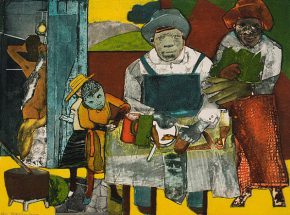

Born in Chattanooga, Tennessee, William Elijah Smith lost his mother at age twelve and journeyed northward with his two young siblings to join his father in Cleveland, Ohio. Ending up on his own in extreme hardship, he was taken in by Rowena and Russell Jelliffe, founders of the settlement house that became Karamu House, the oldest black arts and cultural instituion in the U.S. (founded 1915), and his life opened to great creative possibilities.
It was at Karamu, where Smith studied with Marion Bonsteel, a graduate of the Cleveland Art Institute, and Richard Beatty, who studied at the Carnegie Institute, that Smith encounted printmaking, and gained access and ability with linoleum linocuts, the prints that were the highlight of his career. Concentrating on bold and dynamic compositions featuring high contrasts of light and dark, Smith focused on social realist subject matter, observing the effects on the populace of social and economic conditions of the Great Depression, and the bleak conditions under which many lived. The vitality of his execution managed, however, to give a boying sense of possibility and even hope to these sometimes bleak subject.
